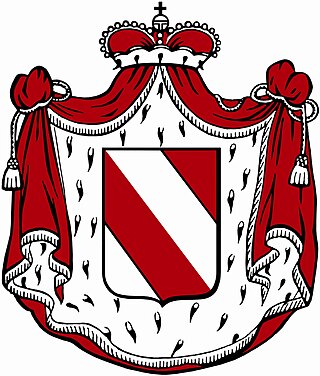
Colditz Castle is a Renaissance castle in the town of Colditz near Leipzig, Dresden and Chemnitz in the state of Saxony in Germany. The castle is between the towns of Hartha and Grimma on a hill spur over the river Zwickauer Mulde, a tributary of the River Elbe. It had the first wildlife park in Germany when, during 1523, the castle park was converted into one of the largest menageries in Europe.

The Zwickauer Mulde is a river in Saxony, Germany. It is the left tributary of the Mulde and 166 km (103 mi) in length.

John was King of Saxony from 9 August 1854 until his death in 1873. He was a member of the House of Wettin. During his reign, Saxony became a part of the German Empire.

Bellevue Palace, located in Berlin's Tiergarten district, has been the official residence of the president of Germany since 1994. The schloss is situated on the banks of the Spree river, near the Berlin Victory Column, along the northern edge of the Großer Tiergarten park. Its name – the French for "beautiful view" – derives from its scenic prospect over the Spree's course.

Warthausen is a municipality in the district of Biberach in Baden-Württemberg in Germany and birthplace of Friedrich Karl von Koenig-Warthausen. Included among its neighbourhoods is Oberhöfen, which hosts the Dorfplatz Feschd every year.

Frederick, Prince of Hohenzollern was the eldest son of William, Prince of Hohenzollern and Princess Maria Teresa of Bourbon-Two Sicilies. He had a twin brother, Franz Joseph, Prince of Hohenzollern-Emden, who was born a few minutes after he was.

Schloss Ebenrain is a former country residence in Sissach, in the canton of Basel-Country, Switzerland. Built in 1774–1776, it is considered the most significant late baroque residence in northwestern Switzerland. It is now a public facility and the site of an agricultural school. It is listed as a Swiss cultural property of national significance.

Osterstein Castle is the former castle of the town of Zwickau, Germany, in Saxony. Now it houses a nursing home.

The House of Schönburg is a noble family of princely and historically sovereign rank. It formerly owned large properties in present-day Saxony, Thuringia and Bohemia. As a former ruling and mediatized family, it belongs to the Hochadel. The family today includes two princely and a comital branch.

Albrechtsberg Palace or Albrechtsberg Castle is a Neoclassical stately home above the Elbe river in the Loschwitz district of Dresden. It was erected in 1854 according to plans designed by the Prussian court and landscaping architect Adolf Lohse (1807–1867) at the behest of Prince Albert, younger brother of the Prussian king Frederick William IV.

Stein Castle is a Saxon castle located southeast of Zwickau in the village of Stein in the municipality of Hartenstein on the rocky banks of the Zwickauer Mulde in the east German state of Saxony.

Hünigen Castle is a castle in the municipality of Konolfingen of the Canton of Bern in Switzerland.

Schloss Ketschendorf is a Gothic Revival residence, located in Ketschendorf, at the foot of the Buchberg, in the town of Coburg, in the state of Bavaria, Germany.

Haardt Castle or Villa Clemm after its builder, is a schloss-like villa in the municipality of Haardt near the town of Neustadt an der Weinstraße in the German state of Rhineland-Palatinate.

Rochsburg Castle, which was probably founded in the late 12th century, stands on a rock spur, surrounded on three sides by the Zwickau Mulde river, above the eponymous town quarter in Lunzenau in Saxony. The medieval site and its division into the inner bailey, outer bailey and two zwingers is still easy to recognise. In its present appearance the schloss dates, however, to the Late Gothic and Renaissance periods. Its main construction phases date to 1470 and 1548; it is an important example of Renaissance architecture in Saxony. Over centuries the Rochsburg has formed the centrepiece in the Saxon district of Rochsburg.

Suvretta House is a five-star hotel in St. Moritz, Switzerland. Built in 1912, it is part of The Leading Hotels of the World. It features 181 rooms and several restaurants.

The House of Poschinger is an ancient Bavarian noble family. Its origin date back to the year 1140. The family received the rank of Knights of the Holy Roman Empire. The Frauenau branch rose to the rank of Barons (Freiherr) in the Kingdom of Bavaria and held a hereditary seat in the House of Councillors.

Schloss Ebnet is a baroque mansion in Ebnet, a district of Freiburg im Breisgau.




















